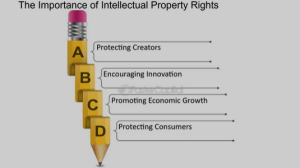In the digital age, protecting intellectual property (IP) is crucial for businesses as advancements in technology have made it easier to reproduce, distribute, and access information. Intellectual property rights encompass various forms of creations, including inventions, literary and artistic works, designs, symbols, names, and images used in commerce. Here are key considerations for businesses regarding intellectual property rights and business protection in the digital age:

Intellectual Property Rights And Business Protection In The Digital Age
Table of Contents
Toggle1. Understanding Types of Intellectual Property:
- Copyright: Protects original works of authorship such as literary, artistic, and musical works.
- Trademarks: Protects symbols, names, and slogans used to identify goods or services.
- Patents: Protects inventions or discoveries, granting exclusive rights to the inventor.
- Trade Secrets: Protects confidential business information and processes.
- Design Patents: Protects the ornamental design of a functional item.
2. Digital Content Protection:
- Watermarking: Embedding digital watermarks in images or documents to identify ownership.
- Digital Rights Management (DRM): Implementing DRM systems to control access to digital content and prevent unauthorized copying.
3. Trademark Protection Online:
- Domain Name Registration: Securing domain names associated with the business to prevent cybersquatting.
- Monitoring and Enforcement: Regularly monitoring online platforms to detect and address trademark infringements.
4. Patent Protection in Technology:
- Patent Filings: Filing patents for new inventions to secure exclusive rights.
- Patent Portfolio Management: Managing a portfolio of patents strategically to protect innovations.
5. Trade Secret Protection:
- Internal Policies: Implementing strict internal policies to safeguard trade secrets.
- Employee Training: Providing employees with training on the importance of trade secret protection.
6. Contracts and Licensing:
- Licensing Agreements: Drafting clear licensing agreements for the use of intellectual property.
- Contractual Protections: Including confidentiality clauses and dispute resolution mechanisms in contracts.
7. Open Source Software Management:
- Compliance: Ensuring compliance with open source licenses when using open source software.
- Documentation: Keeping thorough documentation of software components and their licenses.
8. Social Media and Brand Protection:
- Brand Monitoring: Using tools to monitor social media for brand mentions and potential infringements.
- Social Media Policies: Implementing clear social media policies for employees.
9. Cybersecurity Measures:
- Data Encryption: Encrypting sensitive information to protect it from unauthorized access.
- Firewalls and Security Software: Implementing robust cybersecurity measures to prevent data breaches.
10. International Considerations:
- Global IP Strategy: Developing a comprehensive global IP strategy to protect assets in various jurisdictions.
- Understanding Local Laws: Adhering to intellectual property laws and regulations in each country of operation.
11. Enforcement Strategies:
- Cease and Desist Letters: Sending cease and desist letters to parties infringing on intellectual property.
- Litigation: Pursuing legal action when necessary to protect intellectual property rights.
12. Continuous Monitoring and Updates:
- Regular Audits: Conducting regular audits of intellectual property assets and protections.
- Staying Informed: Keeping abreast of changes in laws and technologies that may impact IP rights.
13. Educating Employees:
- Training Programs: Conducting training programs to educate employees about the importance of intellectual property protection.
- Security Awareness: Fostering a culture of security awareness to prevent inadvertent breaches.
14. Collaboration with Industry Groups:
- Partnerships: Collaborating with industry groups and associations to share information and best practices.
- Information Sharing: Participating in forums for sharing information on emerging threats and trends.
15. Government Assistance:
- Utilizing Government Agencies: Seeking assistance from government agencies responsible for intellectual property protection.
- Legal Resources: Leveraging legal resources provided by government bodies.
Conclusion:
In the digital age, intellectual property is a valuable asset that requires proactive protection. Businesses must employ a multi-faceted approach that includes legal measures, technological solutions, employee education, and continuous monitoring. By implementing robust intellectual property protection strategies, businesses can safeguard their innovations, brands, and competitive advantages in the evolving digital landscape. It’s essential to adapt and stay ahead of emerging threats to ensure the long-term success and sustainability of the business.
